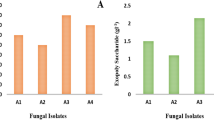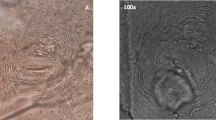Abstract
SOME nematode diseases of crop plants are ameliorated by Brassica, Tagetes or Asparagus grown previously or concurrently in the same soil1–5. Toxic principles within their roots or exuded into the soil are thought to be responsible. Having observed that leaf and root extracts of Polygonum hydropiper L. have nematostatic properties against Rhabditis and other soil nematodes in vitro6, I decided to study its effect on wheat disease caused by the wheat gall nematode, Anguina tritici.
This is a preview of subscription content, access via your institution
Access options
Subscribe to this journal
Receive 51 print issues and online access
$199.00 per year
only $3.90 per issue
Buy this article
- Purchase on SpringerLink
- Instant access to full article PDF
Prices may be subject to local taxes which are calculated during checkout
Similar content being viewed by others
References
Triffitt, M. J., J. Helminthol., 7, 81 (1929).
Ellenby, C., Ann. Appl. Biol., 38, 859 (1951).
Slootweg, A. F. G., Nematologica, 1, 192 (1956).
Rohde, R. A., and Jenkins, W. R., Phytopathology, 48, 463 (1958).
Rohde, R. A., in Nematology, Fundamentals and Recent Advances with Emphasis on Plant Parasitic and Soil Forms (edit. by Sasser, J. N., and Jenkins, W. R.), 447 (University of North Carolina Press, 1960).
Sukul, N. C., Proc. Zool. Soc., Calcutta (in the press).
Leukel, R. W., US Dept Agric. Farmers Bull., 1607 (revised), 1 (1957).
Baermann, G., Tijdsch. Geneesk. Ned.-Ind., 57, 131 (1917).
Author information
Authors and Affiliations
Rights and permissions
About this article
Cite this article
SUKUL, N. Inhibition of Nematode Infestation of Wheat Seedlings by Polygonum hydropiper. Nature 226, 771–772 (1970). https://doi.org/10.1038/226771b0
Received:
Revised:
Issue date:
DOI: https://doi.org/10.1038/226771b0
This article is cited by
-
Wheat seed-gall nematode: going to archives or have local significance in the developing countries?
Indian Phytopathology (2024)



